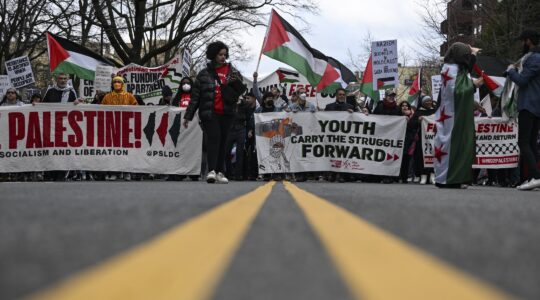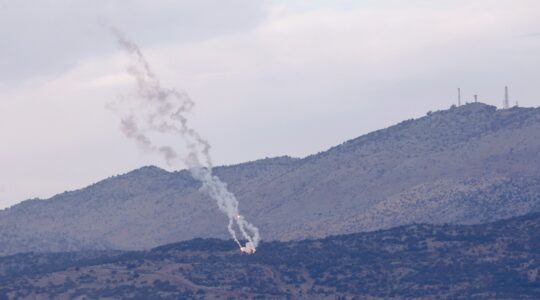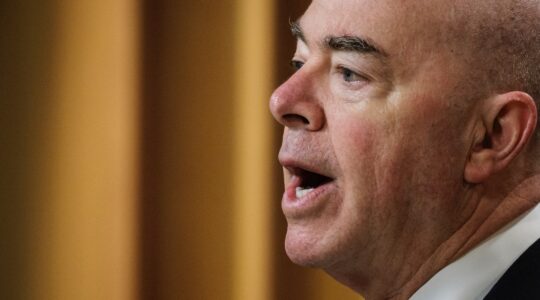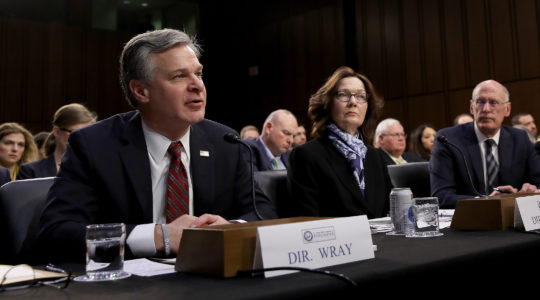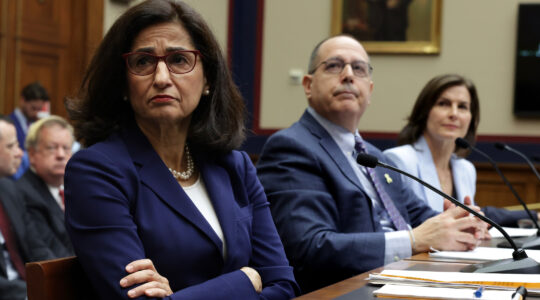ANNAPOLIS, Md. (JTA) – Three-and-a-half centuries ago, on a late day in March 1655, across the river from this city, soldiers waged what essentially amounted to the final battle of the English civil war, a war which included the beheading of King Charles I.
This week, as George W. Bush, Ehud Olmert and Mahmoud Abbas prepare for their upcoming summit in Annapolis, they can only hope that the city will one day be remembered as the place where they took the first step toward a comprehensive peace settlement and not the site where their respective political demises were sealed.
This historic city of 35,000 on Chesapeake Bay is the capital of the state of Maryland and in 1783-84 was the capital of a young America. It was here that the victorious Gen. George Washington resigned his military commission, symbolically bowing in deference to the civilian authority of the Continental Congress. Four signers of the Declaration of Independence had homes here.
Today it is best known as the site of the U.S. Naval Academy. Perhaps surprisingly for an institution that until 1938 required Jewish midshipmen to attend Sunday religious services, the Naval Academy has three buildings named for Jewish officers.
One is for the irascible Adm. Hyman Rickover, a Russian-born Jew credited with developing the American nuclear Navy and choosing a midshipman named Jimmy Carter to work with him.
Another is for academy graduate and Nobel laureate Albert Michelson, who helped to determine the speed of light. A monument at the academy marks the site of some of his experiments.
The third is named for a Jewish sailor from Philadelphia who was court-martialed six times, mainly on false charges brought by bigoted officers. In two cases it took the direct intervention of the president to exonerate Commodore Uriah Phillips Levy, the first Jew to attain flag rank in the U.S. Navy.
Levy is credited with outlawing the flogging of sailors and sometimes is referred to as the “father of American preservation” for rescuing Monticello, the home of President Thomas Jefferson.
Hundreds turned out to rub elbows with admirals, elected officials and midshipmen at the 2005 dedication ceremony for the academy’s gleaming new Jewish chapel named in Levy’s honor by the same Navy whose officers once hated him for being a Jew.
Starting In 1938, Jewish middies could attend “the Jewish church party,” when the sailors would march on Sundays – classes were held on Saturdays – to special services for them at the nearby Congregation Kneseth Israel. Some marriages resulted from encounters at those services with local Jewish girls. The academy ended mandatory attendance at religious services in 1972.
Only a few blocks from the academy, the masonry facade of a prominent corner building at the bottom of Main Street reads “Aaron Lee Goodman.” It’s a reminder that nearly all the stores in downtown Annapolis once were owned by Jews.
By the late 1800s, a sizable Jewish community had formed as merchants and peddlers began to move into many smaller towns that afforded opportunities for shopkeepers. A railroad connection to Baltimore in 1887 and the rebuilding of the Naval Academy in grand fashion in the early 1900s attracted more Jews to Annapolis.
“I think Jews were in large part responsible for transforming Annapolis from kind of a sleepy small town to a more vibrant urban center,” said Eric Goldstein, an Emory University associate professor and Annapolis native who is a scholar of American Jewish history.
The first department store in Annapolis, the Jewish-owned Gottlieb’s, opened in 1899. Jewish merchants also poured the first cement sidewalks and built the first theater.
Today, the Jewish community of Annapolis is believed to be under 2,000 and includes synagogues of the three main streams of Judaism, a day school and a Chabad center.
Annapolis has had a Jewish mayor and City Council members. The State House was occupied by a Jewish governor, Marvin Mandel.
Louis Goldstein, whose statue stands outside the Treasury building in Annapolis that is named in his memory, was a public servant for 60 years. From 1959 until his death in 1998, Goldstein served as the state comptroller. Believed to be the nation’s longest continuously serving elected official, the World War II Marine veteran is fondly remembered for his trademark greeting, “God bless you all real good.”
While this resident welcomes the excitement and attention from the peace negotiations, some Annapolitans may not necessarily want their town to be remembered alongside Oslo or Camp David. Most here like that the Naval Academy itself is known interchangeably s “Annapolis,” as well as for hosting the world’s largest in-the-water boat shows – and largest crab feast.
Of course, how our town will be remembered after November may depend on how Mr. Olmert and Mr. Abbas are able to work together – or not.
They may want to remember, too, another event of historical import that occurred here on Jan. 14, 1784, when the Continental Congress ratified the Treaty of Paris, ending the War of Independence and recognizing the United States.
Perhaps peace negotiators will consider these words from the preamble of the treaty that laid out the goal “to forget all past misunderstandings and differences that have unhappily interrupted the good correspondence and friendship which they mutually wish to restore, and to establish such a beneficial and satisfactory intercourse, between the two countries upon the ground of reciprocal advantages and mutual convenience as may promote and secure to both perpetual peace and harmony.”
Given this history, few places may be better suited to host this conference.
Paul Foer is a writer, consultant and merchant marine officer based in Annapolis.
